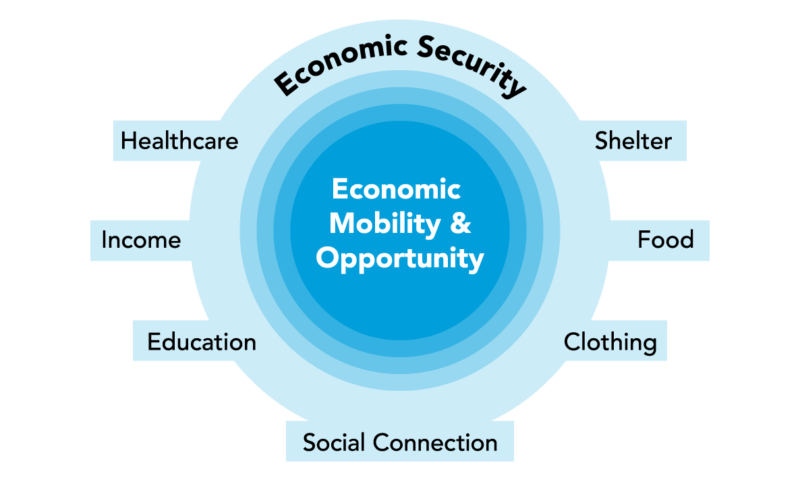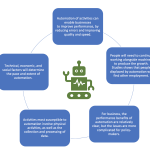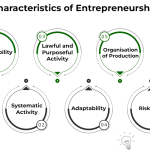Economic mobility, a crucial aspect of societal progress, has been a focal point in discussions about social equity, particularly concerning Black Americans. Recent findings indicate that children from low-income backgrounds, specifically Black Americans, are experiencing significant improvements in their economic prospects, challenging traditional narratives of stagnation and decline. This positive shift highlights the potential for increased economic opportunity and underscores the urgent need to address class gaps that persist across communities. As we delve into the nuances of intergenerational mobility, it becomes clear that these changes are not merely anecdotal but reflect broader trends in the shrinking race gaps observed in America today. Understanding the factors driving these developments can illuminate pathways toward a more equitable future for all families, allowing for greater economic advancement and improved living standards.
In examining the landscape of financial advancement, the concept of socio-economic progression plays a pivotal role in understanding disparities and opportunities. Improvements in financial outcomes for descendants of marginalized groups signal a shift towards greater socio-economic equity, particularly among Black communities. Analysis of class stratification reveals both an encouraging trend in elevating lower-income families and a concerning widening of disparities at the higher end of the spectrum. The dynamics of generational wealth and opportunity highlight how structural factors contribute to changing economic landscapes. By exploring these themes of financial upliftment and class division, we can foster a more comprehensive dialogue surrounding societal growth.
The Evolution of Economic Mobility for Black Americans
Recent studies have indicated a notable shift in economic mobility for Black Americans, particularly for those born into low-income families. In a landmark analysis conducted by Opportunity Insights, it became clear that Black millennials—specifically those born in 1992—have experienced improved earning potentials compared to their Gen X counterparts born in 1978. This trend highlights a significant narrowing of the income gap between Black and white Americans within similar socioeconomic brackets, a shift described by researchers as shrinking race gaps. This progress towards greater economic opportunity can be attributed to various factors, including enhanced access to quality education and employment in regions traditionally burdened with high poverty rates.
Despite these advancements, disparities still remain evident. For Gen Xers from low-income backgrounds, the racial wage gap with white Americans was over $12,000; this figure decreased to approximately $9,500 for millennials, signifying positive movement yet underlining the continued challenges faced by Black Americans. Factors such as historical neighborhood dynamics and parental employment rates were also studied, revealing that community context plays a crucial role in determining economic outcomes for children. Thus, although economic mobility appears to be improving, sustained efforts are essential for ensuring that these trends lead to long-term equitable prosperity.
Understanding Economic Opportunity Across Generations
Economic opportunity is a concept that encompasses the range of factors influencing an individual’s ability to achieve financial success based on their upbringing and environment. The recent research highlights stark contrasts in economic outcomes between generations, emphasizing the need to address both race and class disparities in achieving upward mobility. For instance, the widening class gaps, particularly among low-income white families, reveal that while some groups are progressing, others are experiencing stagnation or decline in their earnings potential. This trend presents a pressing challenge for policymakers aiming to bridge the income divide and foster a more inclusive economy.
Intergenerational mobility remains a critical issue intertwined with these disparities, as children from low-income families continue to face barriers that impede their ability to climb the economic ladder. The study illustrates that while certain areas have improved in providing better economic opportunities, others have seen regression comparable to regions historically associated with poverty. Thus, it is imperative that communities focus on creating supportive infrastructures—such as improved educational systems and job market access—to ensure that all children can benefit from enhanced economic opportunities, regardless of their racial or socioeconomic background.
Class Gaps: A Growing Concern in Economic Studies
The widening class gaps within the American economic landscape are becoming increasingly pronounced, as recent analyses have shown that low-income white Americans are facing a decline in their earnings potential, contrasting sharply with the progress made by low-income Black Americans. This situation complicates the narrative surrounding economic mobility, as it highlights not only the challenges faced by marginalized racial groups but also the growing difficulties within socioeconomically disadvantaged white communities. Understanding these class dynamics is essential for developing targeted interventions that can uplift all disadvantaged populations.
Researchers have pointed out that the geographical context plays a significant role in determining economic outcomes. Regions traditionally associated with robust economic growth and job opportunities are now revealing stark contrasts where low-income individuals—irrespective of race—struggle to keep pace with economic changes. The acceleration of incomes for wealthier individuals, particularly white Americans, further exacerbates the divide. It is crucial to address these evolving class gaps comprehensively, promoting policies that foster economic equity and social mobility across all sectors of the population.
The Impact of Neighborhood Employment on Economic Outcomes
A pivotal finding from the Opportunity Insights study emphasizes the relationship between neighborhood employment rates and the economic mobility of children. Communities with higher rates of employed parents often provide better conditions for children to thrive, leading to improved outcomes in adulthood. This correlation suggests that investing in local economic development and employment opportunities can have profound implications on the long-term financial success of future generations. Ensuring that children grow up in environments with stronger parental employment serves as a foundation for improving economic prospects across different racial and economic backgrounds.
Moreover, the research highlights that socioeconomic improvements in predominantly Black neighborhoods can uplift not just Black families but low-income white families as well. This interconnectedness underscores the importance of fostering inclusive economic policies that benefit entire communities rather than focusing on isolated demographic groups. Community development efforts that aim to bolster employment around these neighborhoods will likely yield significant returns in the form of decreased poverty and increased economic mobility across the board.
Barriers to Economic Opportunity for Low-Income Families
Despite the documented improvements in economic mobility among Black Americans, various barriers still impede sustainable economic opportunity for many families. Factors such as systemic discrimination, access to quality education, and local job market conditions play crucial roles in determining the fate of children born into low-income households. The study indicates that these barriers disproportionately affect families within particular geographic regions, undermining the potential for intergenerational mobility and trapping many individuals in cycles of poverty.
Addressing these obstacles requires a multifaceted approach that includes educational reforms, workforce development, and community support systems. By tackling the root causes of economic disparities, stakeholders can work toward establishing a more egalitarian economic framework. Long-term strategies must focus on improving access to quality schooling and employment opportunities for all disadvantaged youth, thereby enabling them to break free from the limitations of their current environments and achieve their fullest potential.
Regional Insights into Economic Mobility Trends
Regional nuances have emerged as critical factors influencing economic mobility, particularly regarding the progress made by low-income Black Americans. Studies cited in the research indicate that areas like the Southeast and Midwest have seen significant advancements in the earnings of Black millennials compared to earlier generations. For example, the data showed that Black children born in poorer regions manifested substantial growth in their financial outcomes, indicating that regional economic policies and investment play pivotal roles in shaping the prospects of these families.
Conversely, regions with stagnant employment or declining economic conditions have struggled to provide similar benefits to their residents, regardless of race. This disparity reinforces the necessity for targeted regional development policies that address the unique challenges faced by specific areas. By investing in local industry, fostering entrepreneurship, and enhancing access to quality education, communities can pave the way for improved economic mobility, demonstrating the reliance on localized efforts to achieve broader national goals.
Educational Attainment and Economic Advancement
Educational attainment serves as a crucial determinant of economic opportunity and mobility for individuals across all demographics. The research illustrates that higher levels of education correlate positively with improved income potential, particularly for Black Americans who have historically faced barriers to equitable educational access. Rising educational standards and greater availability of resources, especially in historically underprivileged areas, have contributed to a stronger foundation for Black youth seeking to advance economically and achieve stability within their communities.
However, the data also reveals that disparities persist, emphasizing the need for continued reforms in the education system. Low-income students often attend schools that lack essential resources, experienced educators, and enrichment opportunities, which can hinder their academic success and future economic prospects. Policymakers must prioritize equitable funding models and innovative educational programs to ensure that all students, regardless of their background, achieve their academic potential and are well-prepared for the workforce.
Employment Trends and their Economic Implications
The changing landscape of employment trends has substantial implications for economic mobility across racial and class lines. The recent findings from Opportunity Insights shed light on how employment rates influence not only individual earnings but also community health and stability. With declining employment opportunities for low-income families, particularly among white Americans, it is clear that the fabric of community life is being impacted, leading to increased challenges such as rising mortality rates and deteriorating social connections.
Understanding these employment trends is critical as they relate directly to economic mobility. By recognizing that low employment rates amongst parents can lead to poorer outcomes for children, stakeholders can better strategize interventions aimed at fostering job growth within communities. Enhancing workforce development initiatives, providing vocational training, and supporting small businesses could alleviate some of the employment-related challenges captured in the study, ultimately promoting healthier, more economically prosperous communities.
Long-Term Solutions for Economic Disparities
While recent studies indicate progress in economic mobility for Black Americans, long-term solutions are imperative for bridging the remaining gaps caused by race and class disparities. Continued investment in education, job training, and community development will form the backbone of efforts aimed at fostering true economic opportunity for disadvantaged groups. Such initiatives require collaboration between government entities, non-profit organizations, and the private sector to create holistic solutions that address the multifaceted challenges faced by marginalized communities.
Moreover, it is essential to implement policies that ensure that economic growth benefits all layers of society rather than concentrating wealth within a select few. These policies should focus on strengthening social safety nets, increasing accessibility to quality jobs, and promoting equitable economic practices. Only through sustained commitment to these strategies can society hope to eradicate the systemic barriers that have historically hindered the prosperity of low-income racial and ethnic groups.
Frequently Asked Questions
What is economic mobility and how does it relate to Black Americans’ improvement?
Economic mobility refers to the ability of an individual or family to improve their economic status, typically measured by income or wealth over generations. Recent studies indicate that economic mobility has improved for Black Americans born into low-income households, with a significant increase in earnings for this demographic compared to previous generations.
How do shrinking race gaps and growing class gaps affect economic opportunity for Black Americans?
Shrinking race gaps indicate that the economic divide between Black Americans and white Americans is narrowing, facilitating greater economic opportunity for Black individuals. However, the growing class gaps highlight that while some Black Americans are improving their economic mobility, disparities in earnings between low- and high-income groups, particularly among white Americans, are increasing, creating a more complex economic landscape.
What impact does intergenerational mobility have on economic prospects for low-income Black Americans?
Intergenerational mobility reflects the chances that children can achieve a higher economic status than their parents. For low-income Black Americans, recent research shows that intergenerational mobility has improved, meaning younger generations are more likely to escape poverty compared to those born in earlier decades, thereby enhancing their long-term economic prospects.
What are the main factors contributing to improved economic mobility among Black Americans?
Factors contributing to improved economic mobility among Black Americans include better access to quality education, stable employment opportunities in their communities, and structural changes that have increased economic opportunities in specific regions, particularly in the Southeast and Midwest where significant gains have been documented.
How do class gaps influence economic mobility for different racial groups?
Class gaps influence economic mobility by highlighting the disparity in economic outcomes between different income levels. While Black Americans are experiencing shrinking racial gaps in mobility, the widening class gaps indicate that individuals from low-income backgrounds face increasingly significant challenges to achieving upward mobility compared to their wealthier counterparts, regardless of race.
What role does community and parental employment play in economic opportunity?
Community and parental employment are crucial for economic opportunity, as neighborhoods with higher employment rates for parents facilitate better outcomes for children. Research shows that children growing up in environments with strong employment opportunities tend to have higher earnings in adulthood, underscoring the importance of positive community factors in enhancing economic mobility.
How do changes in economic mobility affect the future of Black Americans?
Changes in economic mobility can greatly affect the future of Black Americans by providing increased access to wealth-building opportunities and upward economic movement. As recent studies indicate improvements in earnings for younger Black generations, the potential for breaking the cycle of poverty increases, leading to a more equitable economic landscape.
What evidence exists for improvements in economic mobility for children of low-income Black families?
Evidence from studies, such as those conducted by Opportunity Insights, indicates that children of low-income Black families are seeing notable improvements in their economic mobility compared to their parents. For example, Black millennials are earning more as young adults than their Black Gen X counterparts did at the same age, demonstrating progress in economic opportunities.
| Key Findings | Details |
|---|---|
| Improvement in Economic Outlook | Black Americans born poor have shown better economic prospects in recent years. |
| Widening Class Gap | The income gap between low- and high-income whites continues to grow. |
| Narrowing Race Gap | The earnings gap between poor Black and white Americans has decreased significantly. |
| Historical Context | Research uses 40 years of tax and Census data to analyze long-term trends. |
| Regional Variations | Black Americans see substantial improvements in the Southeast and Midwest. |
| Impact of Community | Childhood communities play a significant role in determining economic mobility. |
| Parent Employment Influence | Higher parental employment rates correlate with better outcomes for children. |
| Changing Dynamics Over Time | Recent data shows improvement in Black millennials compared to Gen Xers. |
Summary
Economic mobility has seen significant shifts in recent years, particularly for Black Americans coming from low-income backgrounds. The latest research indicates that these individuals are experiencing improved economic prospects compared to previous generations. Notably, while the race gap in income is narrowing, the class gap among whites is expanding, highlighting a dual challenge in the pursuit of equity. Overall, this study underscores the importance of community and parental employment in shaping economic outcomes, suggesting that targeted interventions in childhood environments can help enhance economic mobility across different socioeconomic groups.








